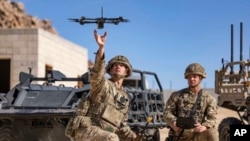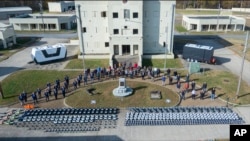United States and Chinese military planners are preparing for a new kind of warfare. The warfare of the future is likely to involve groups of air and sea drones equipped with artificial intelligence (AI).
These drones would use AI to swarm like bees to overcome an enemy.
Development of AI drones
The U.S. Defense Department is pushing for the development of drones because they are less costly. The U.S. says it has no choice but to keep up with China. Chinese officials say AI-enabled weapons are inevitable so they, too, must have them.
Both countries are developing drone swarm technology for military purposes. Such technology permits groups of drones to work together – often without human control.
Margarita Konaev is with Georgetown University’s Center for Security and Emerging Technology (CSET). Konaev said the uncontrolled spread of drone swarm technology “could lead to more instability and conflict around the world.”
As AI superpowers, the U.S. and China can set an example by putting limits on military uses of drone swarms. But the two countries’ competition makes cooperation look unlikely.
The idea of placing restrictions on drone technology is not new. The United Nations has tried for more than 10 years to limit drones. Possible restrictions include the targeting of civilians or banning the use of drone swarms for ethnic cleansing.
Military contracts
Drones have been important for both powers for years, and each side has kept its technologies secret.
In 2023, Georgetown’s CSET released a study of AI-related military spending. It found that more than one third of known contracts issued by both U.S. and Chinese military services over eight months in 2020 were for intelligent uncrewed systems.
Lorenz Meier is chief and founder of Auterion, a company developing drone software that directs drones to work together for the U.S. military and its allies. In a discussion with reporters about drones, Meier said, “We’re enabling a single operator to direct right now half a dozen.” He said that number is expected to increase to dozens and within a year to hundreds.
China’s military claimed last year that dozens of aerial drones “self-healed” after radio jamming cut their communications. An official Chinese government documentary video said they regrouped and switched to self-guidance. The drones completed a search-and-destroy mission unaided, striking a target as planned.
A retired expert urged cooperation
Just before he died last year, former U.S. Secretary of State Henry Kissinger urged China and the U.S. to work together to discourage AI arms spread, or proliferation. The countries have “a narrow window of opportunity,” he said.
With Harvard’s Graham Allison, Kissinger wrote that restrictions were needed “before AI is built into the security structure of each society.”
President Joe Biden and Chinese President Xi Jinping made a spoken agreement in November to set up working groups on AI safety. That effort has not made progress so far.
The competition is not likely to build trust or reduce the risk of conflict, said William Hartung of the Quincy Institute for Responsible Statecraft in Washington, D.C.
If the U.S. is “going full speed ahead, it’s most likely China will accelerate whatever it’s doing,” Hartung said.
Some experts say there is a risk that swarm technology might be given away or stolen. Other countries developing the technology, such as Russia, Israel, Iran and Turkey, could also spread it.
U.S. national security adviser Jake Sullivan said in January that U.S.-China talks set to begin this spring will cover AI safety. Neither the defense secretary’s office nor the National Security Council would comment on whether the military use of drone swarms might be a subject of discussion.
The Chinese Foreign Ministry did not answer an Associated Press request for comment.
I’m John Russell.
Frank Bajak reported on this story for the Associated Press. John Russell adapted it for VOA Learning English.
__________________________________________
Words in This Story
drone –n. a vehicle that is operated from a distance electronically and that does not have a pilot or driver
swarm – v. to have a large number of flying objects, or animals, move together in an effort to attack an enemy
inevitable – adj. sure to happen
instability –n. a state of political or military disorder
ethnic cleansing – n. the act of removing or killing people who belong to an ethnic group that is different from the ruling group
dozen – n. a group of 12 people or things
jam – v. to block signals or messages
discourage – v. to make someone less likely to do something












Forum